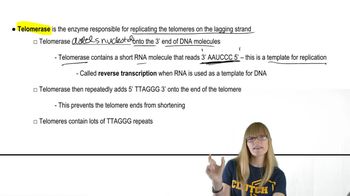Here are the essential concepts you must grasp in order to answer the question correctly.
Telomeres
Telomeres are repetitive nucleotide sequences located at the ends of eukaryotic chromosomes. They protect the chromosome from deterioration and prevent fusion with neighboring chromosomes. Each time a cell divides, telomeres shorten, which is associated with aging and cellular senescence.
Recommended video:
Telomerase
Telomerase is an enzyme that adds nucleotide sequences to the ends of telomeres, effectively extending their length. This enzyme is typically active in germ-line cells, allowing them to maintain telomere length across generations, which is crucial for reproductive success. In contrast, most somatic cells have low or absent telomerase activity, leading to gradual telomere shortening.
Recommended video:
Germ-line vs. Somatic Cells
Germ-line cells are reproductive cells that give rise to gametes (sperm and eggs), while somatic cells make up the rest of the body. The activity of telomerase in germ-line cells ensures that the genetic information is preserved for future generations, whereas somatic cells do not require this mechanism, as they do not contribute directly to reproduction.
Recommended video:





